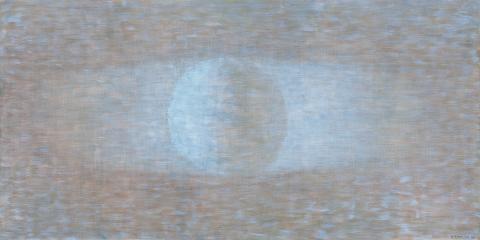PLANET, 1996
HOWARD TAYLOR
synthetic polymer paint and oil on marine ply
120.0 x 240.0 cm
inscribed verso: “PLANET” / H TAYLOR / NORTHCLIFFE. WA 6262
Gallery Dusseldorf, Perth (label attached verso)
Private collection, Perth
Howard Taylor: Tracing the Sublime. Major Paintings - Constructions - Drawings - Maquettes, Gallery Dusseldorf, Perth, 26 March – 23 April 2006 (illus., front cover of exhibition catalogue)
Howard Taylor, Galerie Düsseldorf at the Fifth Australian Contemporary Art Fair, Melbourne, 2 – 6 October 1996, cat. 11
One of Australia’s most admired contemporary artists, Howard Taylor’s achievements span six decades. A lifelong interest in light, colour and the observation of natural phenomena enabled him to hone an unparalleled vision. His art is rigorous, ingenious, subtle, and underscored by artistic precision. The recipient of the inaugural Australia Council Emeritus Award, his work is represented in the collections of the National Gallery of Australia and all State Galleries.
A solo exhibition at the Fifth Australian Contemporary Art Fair, Melbourne in 1996 was the culmination of a year of outstanding achievement for Howard Taylor. Taylor had begun to look anew at the motifs which have structured his art and guided his vision since the 1950s; objects on the ground, objects on the wall and objects in space. Planets, suns and moons were considered by Taylor as excellent objects in space for study and he turned to them repeatedly as subjects of singular and sustaining interest. Planet, 1996 completed in May, was the first in a series of eight sun, moon and planet paintings. This important series includes Day time moon in the collection of the Art Gallery of Western Australia and Bush fire sun, in the Wesfarmers Collection, Perth. All eight paintings are enigmatic objects in space.
Taylor was drawn to the ambiguous visual characteristics of the effects of light on objects and sought out objects he felt remained essentially constant. Pictorially this offered lengthy periods for contemplation and as such the opportunity to capture constantly changing effects of light and atmosphere. Taylor recorded what he saw in exacting detail in hand-made sketchbooks. His notes, sometimes spanning years, served as a constant resource to sustain his ambition to know reality and transform visual discoveries into paintings.
Howard Taylor often revisited subjects and motifs with an attentive vision of objects in the world. For him this was essential and ultimately provided a means to understand vision and perception. The dominant motif throughout his life was objects in space. Always a distillation from nature, his paintings are abstract configurations; his intention throughout to create equivalences for an experience seen in the landscape. The object in space motif, as seen here in Planet, was a pathway to simplification, a way to reduce the wonder in each observation to just the fundamentals of complex natural phenomenon.
Taylor constantly refined an interest in vision-seeking to understand how we see and how in paintings the interaction of support, colour, surface texture, brush strokes and technique serve to unbind nature from romanticism. The success of his technique, as seen in Planet fractures the unity of representation from its subject and slows down the habits of recognition. This rupture in reality creates a temporal rift, a slight pause delaying recognition releasing the subject to be seen as a wholly new visual phenomena, something vital experienced in the present.
Planet gives viewers access to celestial events, creating an image that would otherwise always remain out of reach, invisible, unknowable, a glimpse of something ethereal. In paintings such as this one the unknowable is made a little more real, its scale and active surface reach out. Taylor set himself complex problems and in their resolution sought to bring viewers with him beyond what he described as simply recognition and touch the sublime if only fleetingly, and share with him the wonder that can be found at the core of all human experience. Taylor endeavored to create analogies for what exists, what can be seen if you take the time to look. His works demonstrate that the more one looks the more enlightening and replenishing visual experience and the world becomes.
GARY DUFOUR
